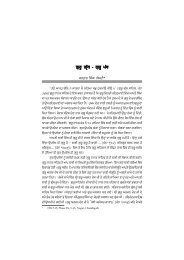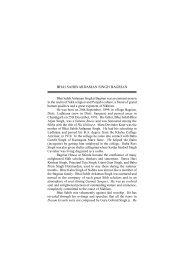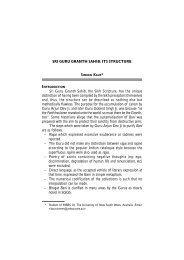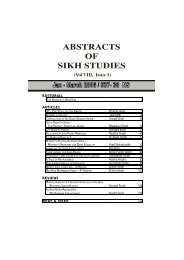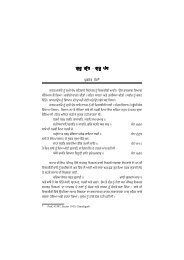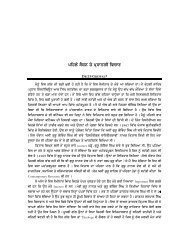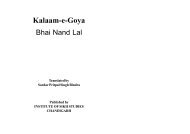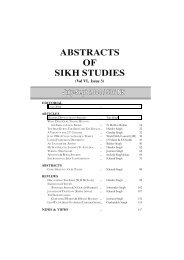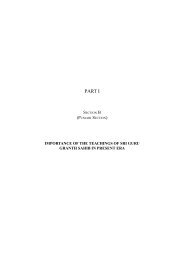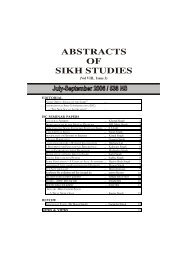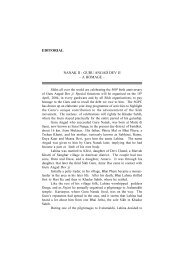editorial articles reviews news & views - Institute of Sikh Studies
editorial articles reviews news & views - Institute of Sikh Studies
editorial articles reviews news & views - Institute of Sikh Studies
You also want an ePaper? Increase the reach of your titles
YUMPU automatically turns print PDFs into web optimized ePapers that Google loves.
72<br />
ABSTRACTS OF SIKH STUDIES : APRIL-JUNE 2005 / 537 NS<br />
McLeod duly takes notice <strong>of</strong> that. He, however, deliberately makes<br />
two cardinal mistakes. One, he says maliciously, “This is widely<br />
regarded as a great pity, even within <strong>Sikh</strong> society where the numerically<br />
preponderant Jat community bewail the fact that there was never a<br />
single Jat Guru.” (pp 87-88). This issue has been raised by him, for<br />
the first time, out <strong>of</strong> extraneous considerations. Two, Ranjit Singh<br />
who seemingly got “total ascendancy” in Punjab was not a Jat but a<br />
Sansi, and it was only that class <strong>of</strong> Sansis that was admitted into Jat<br />
class, whereas other Sansis continued to be enumerated as criminal<br />
tribes under the British.<br />
Now look at his tradition <strong>of</strong> Khalsa which he says, borrowed<br />
heavily from the Jats’ cultural pattern. He says, “Uncut hair was a Jat<br />
custom which was evidently observed by Hindu and Muslim Jats as<br />
well as by <strong>Sikh</strong> Jats.” Further that, “With these two symbols may be<br />
paired the comb and the bangle, respectively. “Of the breech”, he<br />
continues, “it seems safe to assume that this symbol must also relate<br />
in some way to the same situation.” (McLeod, p 52)<br />
On Jats, McLeod is not supported even by his once collaborator<br />
J S Grewal, who says that McLeod’s <strong>views</strong> that Jat cultural pattern<br />
provided ingredients <strong>of</strong> Khalsa code was untenable. It was “contrary<br />
to historical facts” and “McLeod’s assumption that Jats wore uncut<br />
hair remained unsupported by evidence.” One wishes these were so.<br />
But it seems that McLeod must have been under the influence <strong>of</strong><br />
bhang, hemp, when he wrote atleast this paragraph, if not the entire<br />
book. Again, when he says that Khalsa “slate must be wiped clean”,<br />
he only reflected what (Mahatma) M.K. Gandhi once said, “the Guru<br />
has not said anywhere that you must grow beards, carry kirpan and so<br />
on.” McLeod was obviously following the brief held for him.<br />
One can say that the Evolution <strong>of</strong> the <strong>Sikh</strong> Community published<br />
after 1994 when the Indian state gained ascendancy over the <strong>Sikh</strong><br />
youth in making them discard keshas, hair, in a way reflected an<br />
extraneous situation, and came quite handy to the Indian setup.<br />
It is these asinine qualities that form McLeod’s postulates and<br />
perverse presentation <strong>of</strong> <strong>Sikh</strong> ethos and tradition. Some one else<br />
shall be presenting a detailed analysis <strong>of</strong> McLeodian shenanigans.



